Abstract
Clinical and pathologic data from 73 patients with unresectable carcinoma of the pancreas treated from 1980 to 1987 were reviewed to evaluate the efficacy of biliary enteric bypass and percutaneous transhepatic biliary drainage (PTBD) in the treatment of malignant biliary obstruction. Fifty-two patients underwent biliary enteric bypass with no operative deaths and with a 15% operative morbidity. These patients had a median postoperative hospitalization of 12 days. Four patients (8%) eventually developed recurrent jaundice, and three of these were successfully treated with PTBD. The median survival for these 52 patients was 7 months. Twenty-one patients underwent PTBD with an 81% technical-success rate. These patients had a 33% early complication rate and a 33% in-hospital mortality. The median hospitalization was 13 days postdrainage. Of the 14 patients surviving the initial hospitalization, 86% developed late complications requiring 16 hospital admissions and ten emergency room visits for a total of 155 days of hospitalization. The median survival for those patients undergoing PTBD was 4 months from the time of diagnosis and 2 months from the time of catheter drainage. Surgical bypass offers excellent palliation for malignant biliary obstruction with extremely low morbidity and mortality in properly selected patients; PTBD is useful in the treatment of those patients with extensive disease, who are poor surgical candidates, or who have failed previous surgical drainage. There is a role for both of these palliative procedures in the management of patients with biliary obstruction from pancreatic cancer.
Full text
PDF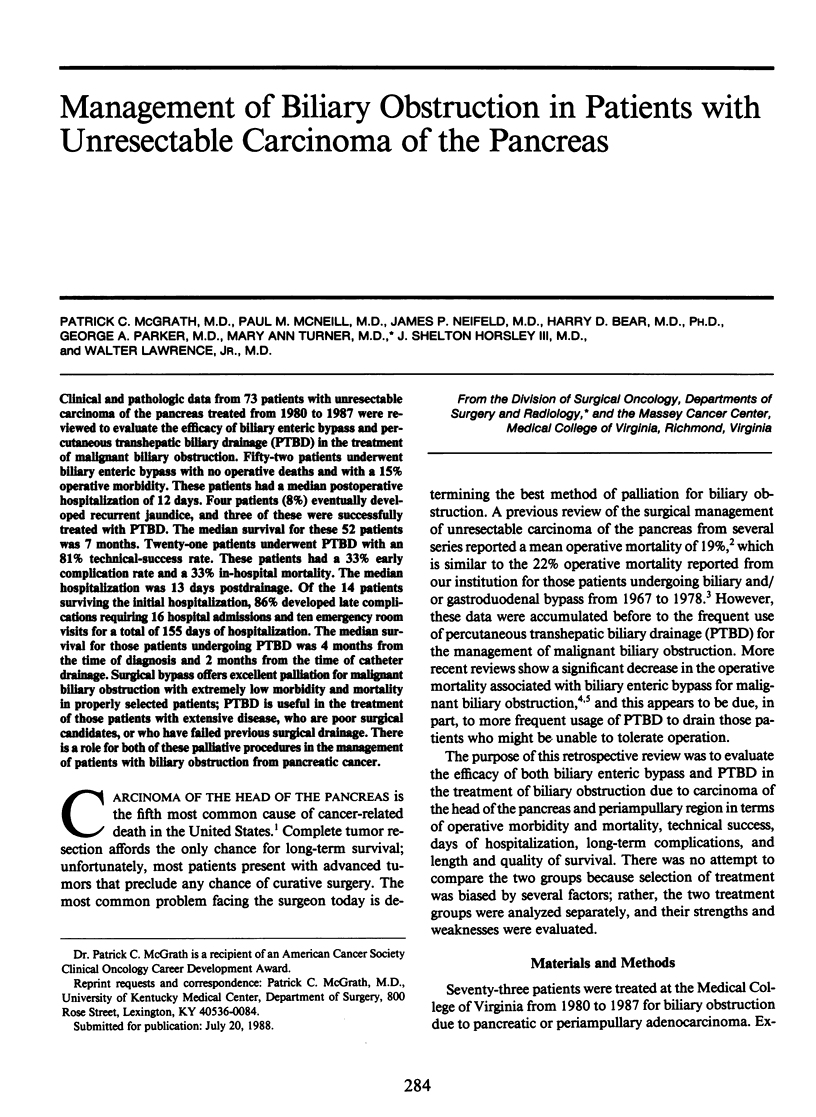
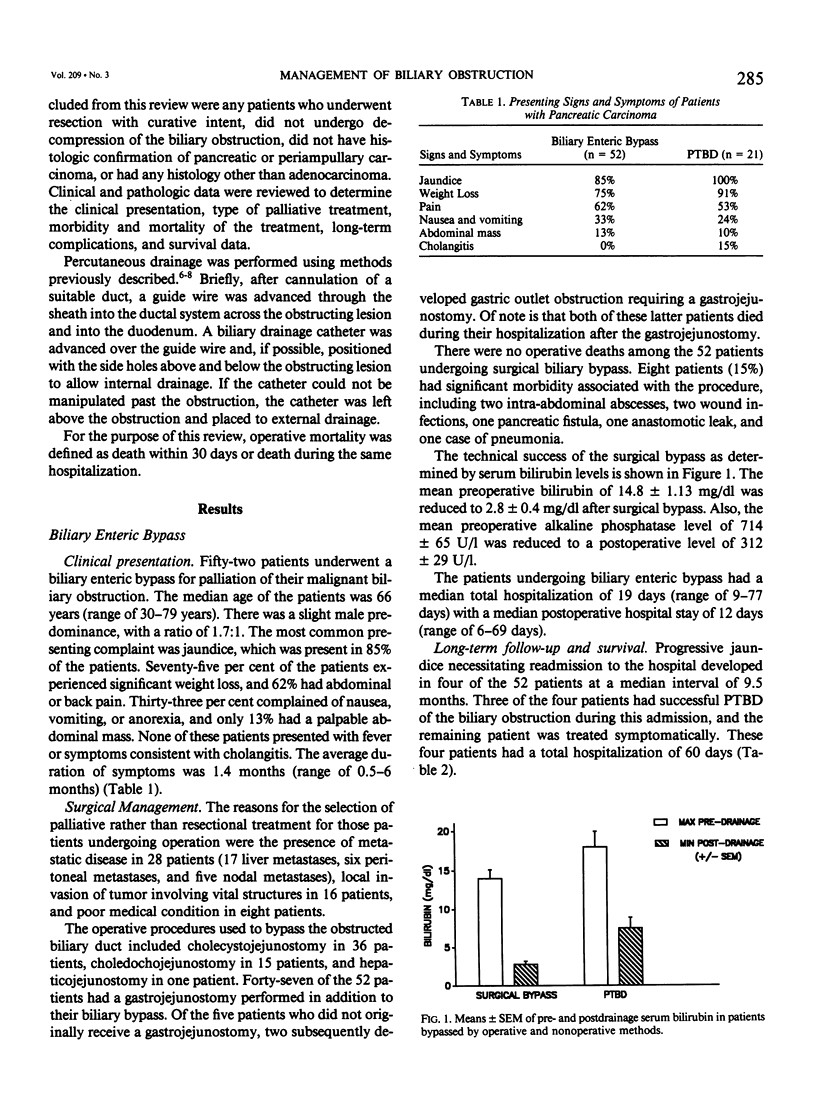
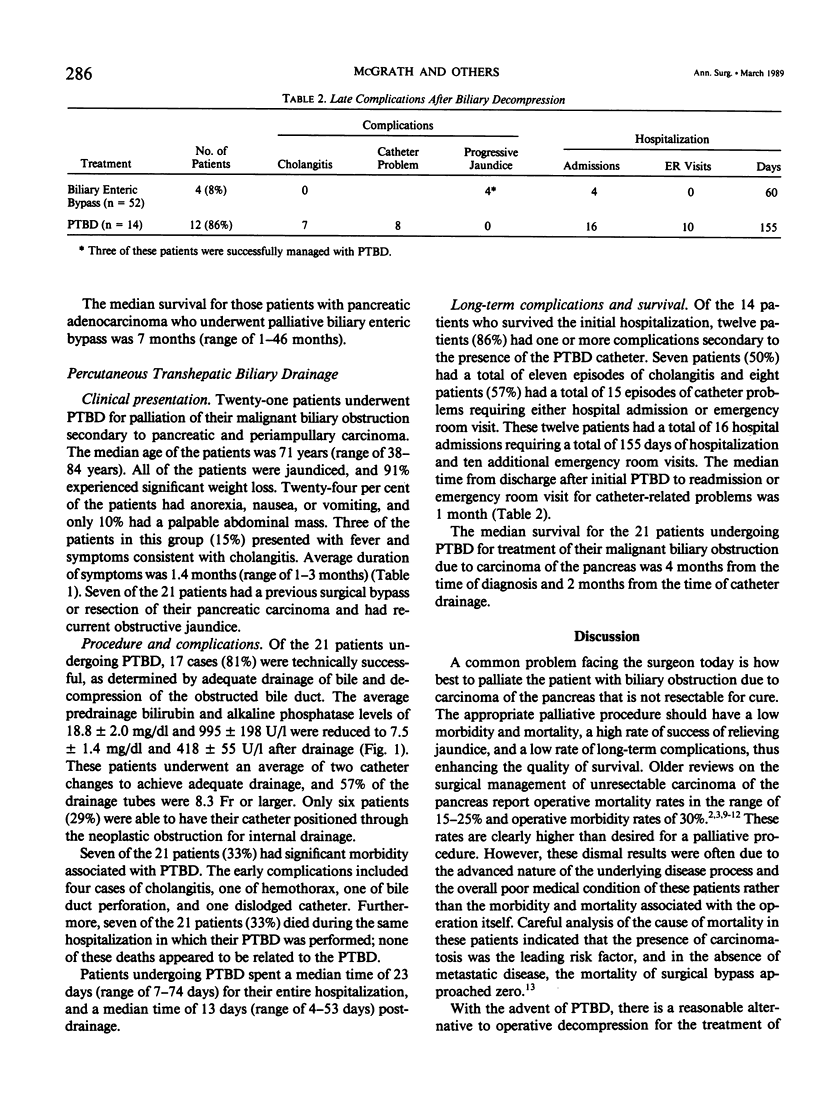
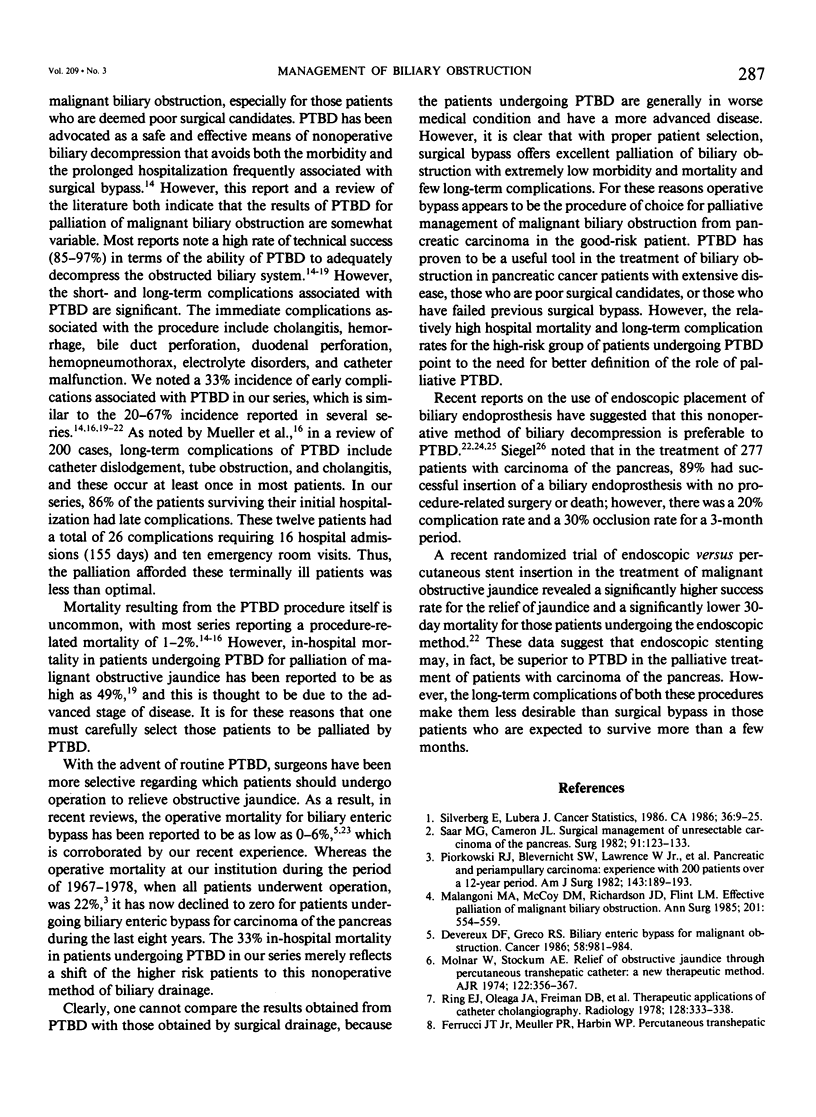
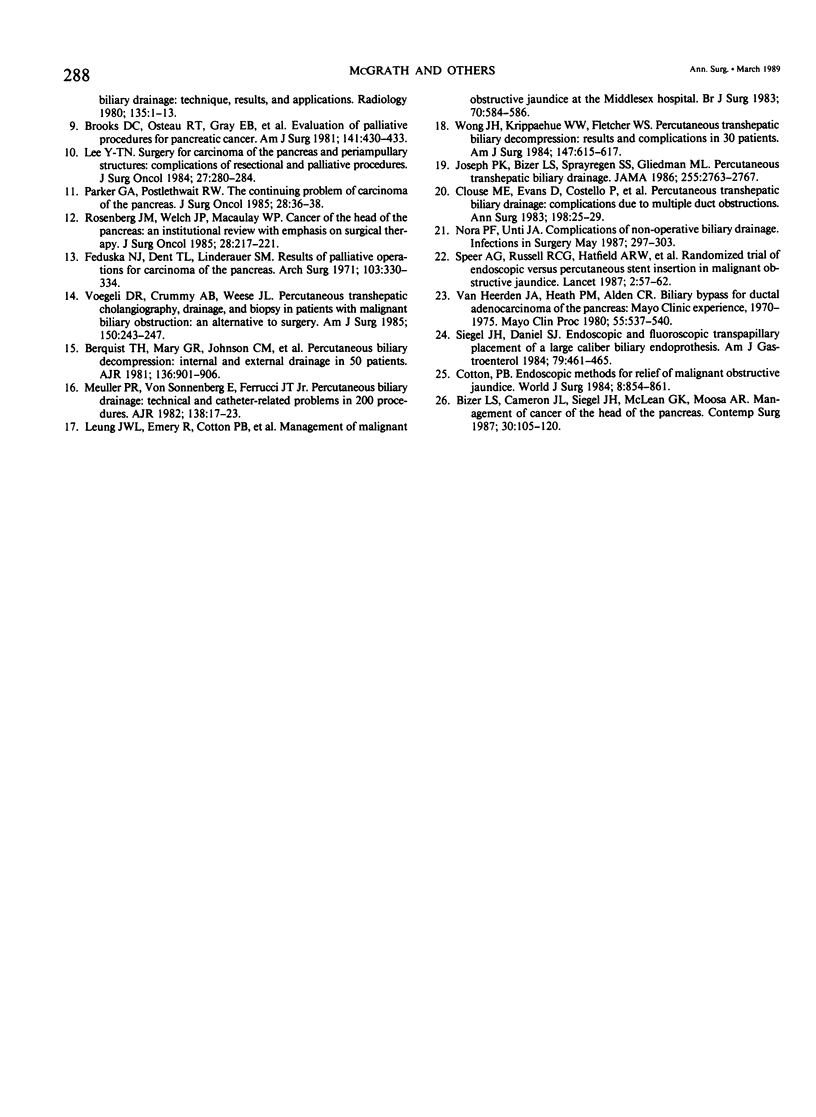
Selected References
These references are in PubMed. This may not be the complete list of references from this article.
- Berquist T. H., May G. R., Johnson C. M., Adson M. A., Thistle J. L. Percutaneous biliary decompression: internal and external drainage in 50 patients. AJR Am J Roentgenol. 1981 May;136(5):901–906. doi: 10.2214/ajr.136.5.901. [DOI] [PubMed] [Google Scholar]
- Brooks D. C., Osteen R. T., Gray E. B., Jr, Steele G. D., Jr, Wilson R. E. Evaluation of palliative procedures for pancreatic cancer. Am J Surg. 1981 Apr;141(4):430–433. doi: 10.1016/0002-9610(81)90135-5. [DOI] [PubMed] [Google Scholar]
- Clouse M. E., Evans D., Costello P., Alday M., Edwards S. A., McDermott W. V., Jr Percutaneous transhepatic biliary drainage. Complications due to multiple duct obstructions. Ann Surg. 1983 Jul;198(1):25–29. [PMC free article] [PubMed] [Google Scholar]
- Cotton P. B. Endoscopic methods for relief of malignant obstructive jaundice. World J Surg. 1984 Dec;8(6):854–861. doi: 10.1007/BF01656025. [DOI] [PubMed] [Google Scholar]
- Devereux D. F., Greco R. S. Biliary enteric bypass for malignant obstruction. Cancer. 1986 Aug 15;58(4):981–984. doi: 10.1002/1097-0142(19860815)58:4<981::aid-cncr2820580431>3.0.co;2-x. [DOI] [PubMed] [Google Scholar]
- Feduska N. J., Dent T. L., Lindenauer S. M. Results of palliative operations for carcinoma of the pancreas. Arch Surg. 1971 Aug;103(2):330–334. doi: 10.1001/archsurg.1971.01350080246039. [DOI] [PubMed] [Google Scholar]
- Joseph P. K., Bizer L. S., Sprayregen S. S., Gliedman M. L. Percutaneous transhepatic biliary drainage. Results and complications in 81 patients. JAMA. 1986 May 23;255(20):2763–2767. [PubMed] [Google Scholar]
- Lee Y. T. Surgery for carcinoma of the pancreas and periampullary structures: complications of resectional and palliative procedures. J Surg Oncol. 1984 Dec;27(4):280–285. doi: 10.1002/jso.2930270418. [DOI] [PubMed] [Google Scholar]
- Leung J. W., Emery R., Cotton P. B., Russell R. C., Vallon A. G., Mason R. R. Management of malignant obstructive jaundice at The Middlesex Hospital. Br J Surg. 1983 Oct;70(10):584–586. doi: 10.1002/bjs.1800701006. [DOI] [PubMed] [Google Scholar]
- Malangoni M. A., McCoy D. M., Richardson J. D., Flint L. M. Effective palliation of malignant biliary duct obstruction. Ann Surg. 1985 May;201(5):554–559. doi: 10.1097/00000658-198505000-00003. [DOI] [PMC free article] [PubMed] [Google Scholar]
- Molnar W., Stockum A. E. Relief of obstructive jaundice through percutaneous transhepatic catheter--a new therapeutic method. Am J Roentgenol Radium Ther Nucl Med. 1974 Oct;122(2):356–367. doi: 10.2214/ajr.122.2.356. [DOI] [PubMed] [Google Scholar]
- Mueller P. R., van Sonnenberg E., Ferrucci J. T., Jr Percutaneous biliary drainage: technical and catheter-related problems in 200 procedures. AJR Am J Roentgenol. 1982 Jan;138(1):17–23. doi: 10.2214/ajr.138.1.17. [DOI] [PubMed] [Google Scholar]
- Parker G. A., Postlethwait R. W. The continuing problem of carcinoma of the pancreas. J Surg Oncol. 1985 Jan;28(1):36–38. doi: 10.1002/jso.2930280110. [DOI] [PubMed] [Google Scholar]
- Piorkowski R. J., Blievernicht S. W., Lawrence W., Jr, Madariaga J., Horsley J. S., 3rd, Neifeld J. P., Terz J. J. Pancreatic and periampullary carcinoma. Experience with 200 patients over a 12 year period. Am J Surg. 1982 Feb;143(2):189–193. doi: 10.1016/0002-9610(82)90064-2. [DOI] [PubMed] [Google Scholar]
- Ring E. J., Oleaga J. A., Freiman D. B., Husted J. W., Lunderquist A. Therapeutic applications of catheter cholangiography. Radiology. 1978 Aug;128(2):333–338. doi: 10.1148/128.2.333. [DOI] [PubMed] [Google Scholar]
- Rosenberg J. M., Welch J. P., Macaulay W. P. Cancer of the head of the pancreas: an institutional review with emphasis on surgical therapy. J Surg Oncol. 1985 Mar;28(3):217–221. doi: 10.1002/jso.2930280315. [DOI] [PubMed] [Google Scholar]
- Sarr M. G., Cameron J. L. Surgical management of unresectable carcinoma of the pancreas. Surgery. 1982 Feb;91(2):123–133. [PubMed] [Google Scholar]
- Siegel J. H., Daniel S. J. Endoscopic and fluoroscopic transpapillary placement of a large caliber biliary endoprosthesis. Am J Gastroenterol. 1984 Jun;79(6):461–465. [PubMed] [Google Scholar]
- Silverberg E. Cancer statistics. 1986. CA Cancer J Clin. 1986 Jan-Feb;36(1):9–25. doi: 10.3322/canjclin.36.1.9. [DOI] [PubMed] [Google Scholar]
- Speer A. G., Cotton P. B., Russell R. C., Mason R. R., Hatfield A. R., Leung J. W., MacRae K. D., Houghton J., Lennon C. A. Randomised trial of endoscopic versus percutaneous stent insertion in malignant obstructive jaundice. Lancet. 1987 Jul 11;2(8550):57–62. doi: 10.1016/s0140-6736(87)92733-4. [DOI] [PubMed] [Google Scholar]
- Voegeli D. R., Crummy A. B., Weese J. L. Percutaneous transhepatic cholangiography, drainage, and biopsy in patients with malignant biliary obstruction. An alternative to surgery. Am J Surg. 1985 Aug;150(2):243–247. doi: 10.1016/0002-9610(85)90129-1. [DOI] [PubMed] [Google Scholar]
- Wong J. H., Krippaehne W. W., Fletcher W. S. Percutaneous transhepatic biliary decompression. Results and complications in 30 patients. Am J Surg. 1984 May;147(5):615–617. doi: 10.1016/0002-9610(84)90125-9. [DOI] [PubMed] [Google Scholar]
- van Heerden J. A., Heath P. M., Alden C. R. Biliary bypass for ductal adenocarcinoma of the pancreas: Mayo Clinic experience, 1970-1975. Mayo Clin Proc. 1980 Sep;55(9):537–540. [PubMed] [Google Scholar]


